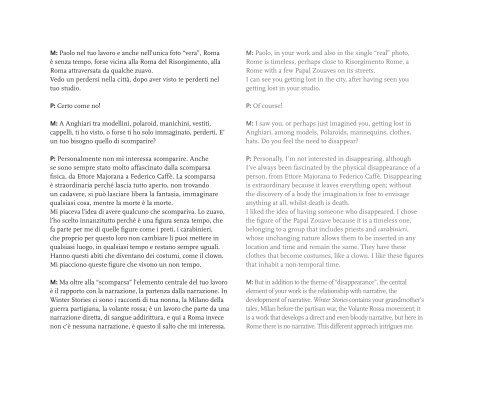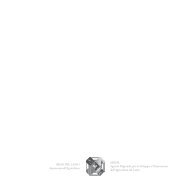lo zuavo scomparso
lo zuavo scomparso
lo zuavo scomparso
- No tags were found...
You also want an ePaper? Increase the reach of your titles
YUMPU automatically turns print PDFs into web optimized ePapers that Google loves.
M: Pao<strong>lo</strong> nel tuo lavoro e anche nell’unica foto “vera”, Romaè senza tempo, forse vicina alla Roma del Risorgimento, allaRoma attraversata da qualche <strong>zuavo</strong>.Vedo un perdersi nella città, dopo aver visto te perderti neltuo studio.P: Certo come no!M: A Anghiari tra modellini, polaroid, manichini, vestiti,cappelli, ti ho visto, o forse ti ho so<strong>lo</strong> immaginato, perderti. E’un tuo bisogno quel<strong>lo</strong> di scomparire?P: Personalmente non mi interessa scomparire. Anchese sono sempre stato molto affascinato dalla scomparsafisica, da Ettore Majorana a Federico Caffè. La scomparsaè straordinaria perché lascia tutto aperto, non trovandoun cadavere, si può lasciare libera la fantasia, immaginarequalsiasi cosa, mentre la morte è la morte.Mi piaceva l’idea di avere qualcuno che scompariva. Lo <strong>zuavo</strong>,l’ho scelto innanzitutto perché è una figura senza tempo, chefa parte per me di quelle figure come i preti, i carabinieri,che proprio per questo <strong>lo</strong>ro non cambiare li puoi mettere inqualsiasi luogo, in qualsiasi tempo e restano sempre uguali.Hanno questi abiti che diventano dei costumi, come il c<strong>lo</strong>wn.Mi piacciono queste figure che vivono un non tempo.M: Ma oltre alla “scomparsa” l’elemento centrale del tuo lavoroè il rapporto con la narrazione, la partenza dalla narrazione. InWinter Stories ci sono i racconti di tua nonna, la Milano dellaguerra partigiana, la volante rossa; è un lavoro che parte da unanarrazione diretta, di sangue addirittura, e qui a Roma invecenon c’è nessuna narrazione, è questo il salto che mi interessa.M: Pao<strong>lo</strong>, in your work and also in the single “real” photo,Rome is timeless, perhaps c<strong>lo</strong>se to Risorgimento Rome, aRome with a few Papal Zouaves on its streets.I can see you getting <strong>lo</strong>st in the city, after having seen yougetting <strong>lo</strong>st in your studio.P: Of course!M: I saw you, or perhaps just imagined you, getting <strong>lo</strong>st inAnghiari, among models, Polaroids, mannequins, c<strong>lo</strong>thes,hats. Do you feel the need to disappear?P: Personally, I’m not interested in disappearing, althoughI’ve always been fascinated by the physical disappearance of aperson, from Ettore Majorana to Federico Caffè. Disappearingis extraordinary because it leaves everything open; withoutthe discovery of a body the imagination is free to envisageanything at all, whilst death is death.I liked the idea of having someone who disappeared. I chosethe figure of the Papal Zouave because it is a timeless one,be<strong>lo</strong>nging to a group that includes priests and carabinieri,whose unchanging nature al<strong>lo</strong>ws them to be inserted in any<strong>lo</strong>cation and time and remain the same. They have thesec<strong>lo</strong>thes that become costumes, like a c<strong>lo</strong>wn. I like these figuresthat inhabit a non-temporal time.M: But in addition to the theme of “disappearance”, the centralelement of your work is the relationship with narrative, thedeve<strong>lo</strong>pment of narrative. Winter Stories contains your grandmother’stales, Milan before the partisan war, the Volante Rossa movement; itis a work that deve<strong>lo</strong>ps a direct and even b<strong>lo</strong>ody narrative, but here inRome there is no narrative. This different approach intrigues me.







